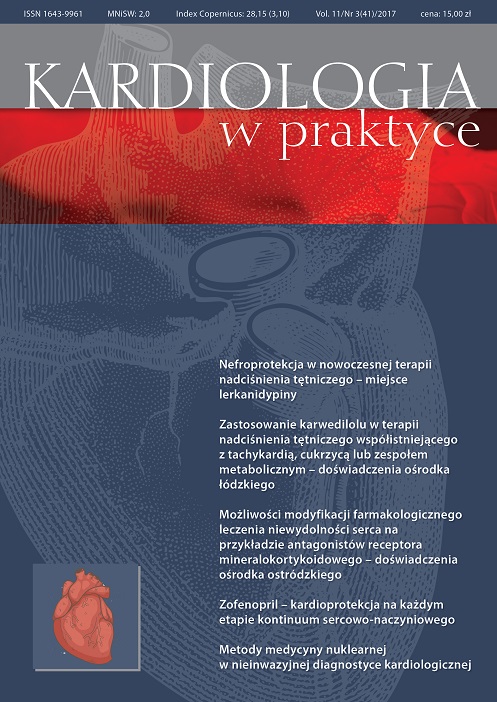The use of carvedilol in the treatment of arterial hypertension coexisting with tachycardia, diabetes mellitus or metabolic syndrome – experience of Łódź center Case report
Main Article Content
Abstract
Carvedilol is the third-generation β-adrenolytic with unique pleiotropic properties. It reduces peripheral resistance, lower insulin resistance and improve glycemic control, exerting beneficial effects on the individual components of the metabolic syndrome and the development of microalbuminuria. These properties determine the preference of carvedilol in hypertension with concomitant diabetes or metabolic syndrome.
Downloads
Article Details

This work is licensed under a Creative Commons Attribution-NonCommercial 4.0 International License.
Copyright: © Medical Education sp. z o.o. This is an Open Access article distributed under the terms of the Attribution-NonCommercial 4.0 International (CC BY-NC 4.0). License (https://creativecommons.org/licenses/by-nc/4.0/), allowing third parties to copy and redistribute the material in any medium or format and to remix, transform, and build upon the material, provided the original work is properly cited and states its license.
Address reprint requests to: Medical Education, Marcin Kuźma (marcin.kuzma@mededu.pl)
References
2. Kluk M., Wożakowska-Kapłon B.: Częstość pracy serca a leczenie niepowikłanego nadciśnienia tętniczego. Choroby Serca i Naczyń 2013; 10(3): 123-130.
3. Filipiak K.J., Tykarski A., Czarnecka D. et al.: Miejsce wazodylatacyjnych leków beta-adrenolitycznych w terapii nadciśnienia tętniczego i jego powikłań sercowo-naczyniowych. Stanowisko ekspertów. Nadciśnienie Tętnicze 2010; 14(6): 421-433.
4. Mancia G., Fagard R., Narkiewicz K. et al.: 2013 ESH/ESC Guidelines for the management of arterial hypertension: The Task Force for the management of arterial hypertension of the European Society of Hypertension (ESH) and of the European Society of Cardiology (ESC). J. Hypertens. 2013; 31(7): 1281-1357.
5. Tykarski A., Narkiewicz K., Gaciong Z. et al.: Zasady postępowania w nadciśnieniu tętniczym – 2015 rok. Wytyczne Polskiego Towarzystwa Nadciśnienia Tętniczego. Nadciśnienie Tętnicze w Praktyce 2015; 1(1): 1-70.
6. Zalecenia kliniczne dotyczące postępowania u chorych na cukrzycę 2016. Stanowisko Polskiego Towarzystwa Diabetologicznego. Diabetologia Kliniczna 2016; 5(supl. A): 1-76.
7. Sakiewicz W., Szczęch R., Narkiewicz K.: Beta-adrenolityki u pacjentów ze współistniejącym nadciśnieniem tętniczym i cukrzycą typu 2 – korzystny wpływ karwedilolu na profil metaboliczny. Przew. Lek. 2005; 3: 140-144.
8. Packer M., Coats A.J., Flower M.B. et al.: Effect of carvedilol on survival in severe chronic heart failure. N. Engl. J. Med. 2001; 344: 1651-1658.
9. Nakamura K., Kusano K., Nakamura Y.: Carvedilol decreases elevated oxidative stress in human failing myocardium. Circulation 2002; 105: 2867-2871.
10. Poole-Wilson P.A., Swedberg K., Cleland J.G. et al.: Comparison of carvedilol and metoprolol on clinical outcomes in patients with chronic heart failure in the Carvedilol or Metoprolol European Trial (COMET): randomized controlled trial. Lancet 2003; 362: 7-13.
11. Bank A.J., Kelly A.S., Thelen A.M. et al.: Effects of carvedilol versus metoprolol on endothelial function and oxidative stress in patients with type 2 diabetes mellitus. Am. J. Hypertens. 2007; 20: 777-783.
12. Kovacić D., Marinsek M., Gobec L. et al.: Effect of selective and non-selective beta-blockers on body weight, insulin resistance and leptin concentration in chronic heart failure. Clin. Res. Cardiol. 2008; 97: 24-31.
13. Bakris G.L., Fonseca V., Katholi R.E. et al.; GEMINI Investigators: Metabolic effects of carvedilol vs metoprolol in patients with type 2 diabetes mellitus and hypertension: a randomized controlled trial. JAMA 2004; 292(18): 2227-2236.

